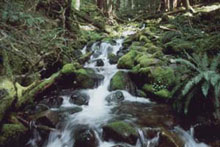
Water cycles endlessly through the forest ecosystem, sustaining the entire living web—including salmon and people. (Photo: Olympic National Park).
Every Canoe Begins As Water
By Robert Steelquist
Education Coordinator
Olympic Coast National Marine Sanctuary
The Northwest Coast ocean canoe starts as a living tree, perhaps a thousand years old. Every fiber of wood contains vessels that transport moisture from the roots to the tip of each branch. But to be drawn from damp soil, course upward through the tree’s cells and finally, be exhaled into the atmosphere, is only a small part of water’s journey. Endlessly, water cycles between the oceans and the atmosphere, falls to earth, rests in glacial ice or flows in streams and rivers and returns to the ocean. Along the way, it nourishes life—everything from the cedar tree, the paddler and the animals here stylized in the decoration of the canoe.
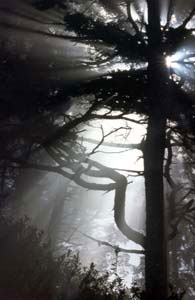
The Northwest's coastal forests evolved along with the maritime climate—products of a shift in ocean currents and conditions about 6,600 years ago. (Photo: Olympic National Park)
As the tree grows, the living vessels become wood, cells stacked in long chains forming the even grain, porous, supple and light. Over decades and centuries, the wood forms layers and adds girth to the tree. Wind and storms stress the growing tree, forming ribs and buttresses along the tall trunk. Amid the forest, a massive structure arises. Its whole purpose is to push the green needles into the light, where photosynthesis takes place. After perhaps five or six decades, the cedar tree begins to grow multiple tops that give the tree the look of a candelabra. The shaggy bark thickens making the tree resistant to fire. In time, shrubs and small trees root among the limbs. A single tree can seem to support its own small forest.
The climatic conditions that gave rise to the great forests of the Northwest Coast are recent in time. Pollen studies have shown that immediately following the end of the last ice age, the climate was drier and warmer than today. Red cedar made its appearance in the forest community about 6,600 years ago, setting the stage for the rich technology and material cultures of Northwest Coast prehistoric people. With cedar, came the longhouses, the multitude of tools, bark-fiber fabrics and the great canoes. And with the canoes, came an alliance with the ocean—as the people’s highway, food provider and companion.
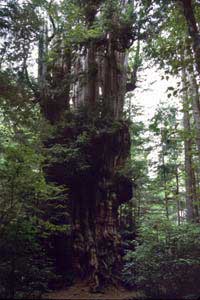
The wood of Western red cedar (Thuja plicata) is light, buoyant, easy to work and rot resistant. Trees as old as 1,000 years stand as sentinels in the forest. Their great size and abundance made the Northwest Canoe culture possible. (Photo: Robert Steelquist)
The maritime climate in the Pacific Northwest is a benign one. Coastal forests receive up to 170 inches of rain each year, mostly in the fall, winter and spring months. Winter temperatures in the lowlands only reach freezing infrequently. The land stays green, even with shortened days and gloomy, overcast skies. The fall freshets in the rivers signal the return of salmon, a burst of nutrients returning to the land, fat with ocean plenty. The short days hold people in their villages, making and repairing tools and objects of art. The year-round abundance of shellfish and game holds back hunger. The long nights fill with song and gatherings of families and villages and societies.
With canoes, the people were mobile. They could trade food and raw materials. They could trade customs, songs, dances and stories. They intermarried. With the canoe, whole cultures arose and spread. Traditional knowledge passed from village to village, mainland to island, island to island and inlet to inlet. Art forms, methods of preparing and preserving food, tools and how to use them traveled between communities. With the canoe arose the Northwest Coast culture—perhaps one of the wealthiest of all North American cultural patterns at the time of European contact.
And with the canoe emerged intimacy with the ocean. Daily experience accumulating over generations about fish, seal and whale abundance, tide cycles, currents, shifting weather, good places to land, harbors for refuge, the routes to distant relatives. Along with skill and insight of its makers and handlers, the canoe enabled the people a mastery over their places—a measure of control over the environment.
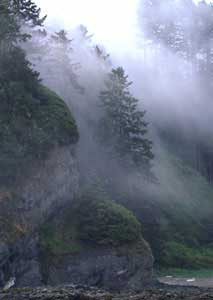
In the Northwest, ocean and forest are intertwined in a single system. (Photo: Robert Steelquist)
To an extent, canoe people traveled at will—settled permanently at good harbors, fished and hunted remote islands and banks, migrated with the plant and animal resources that sustained them. Whole families could travel together. Whole villages could visit one another. Our current concept of a “Pacific Rim” had its prehistoric precedent.
There is, in the rebirth of the ocean canoe of the Northwest, the rebirth of a Canoe Nation. Villages and tribes, divided by distance, past and present language and country and political structure are being reunited as their ancestors knew themselves as one. Young people and elders are sharing stories of the ocean and their respective journeys. Leaders are emerging whose wisdom crosses tribal lines. New canoes are being carved and blessed each year and new celebrations draw the canoe people together. The water, the geographic boundary that confines our land-bound transportation systems, is once again a highway linking places, and the present with the past.
Every canoe begins as water. The ocean breathes onto the land. The rain nourishes a forest. A forest nurses a cedar tree. A tree lives a thousand years and becomes a canoe. A canoe gives identity and movement to a crew of paddlers. Pulling and singing together, the people reenact with each stroke a timeless bond to the ocean.

With the canoe, water's edge is a mere transition between equally accessible worlds. (Photo: Robert Steelquist)
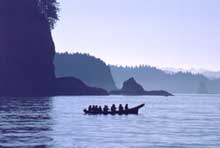
In a scene that could be hundred—or thousands—of years old, the human need to explore is realized. Raven Spirit approaches Hoh River. (Photo: Robert Steelquist)
Sign up for the Ocean Explorer E-mail Update List.








